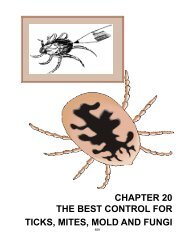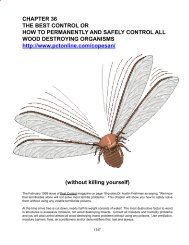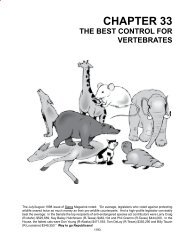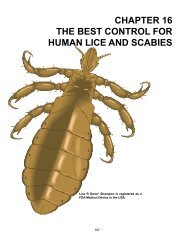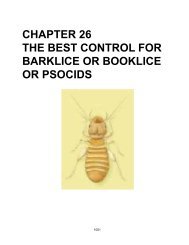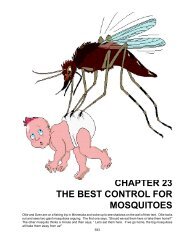Hawthorne Extract - will guard your heart. Heart disease is the number one killer in America. See Chapter 41.Healthy Plants - Purchase stocky, dark green transplants, certified virus-free seed, potatoes and fruit. All healthyplants contain compounds that naturally make them resistant and/or toxic to many pests. Healthy, strong plantsresist stress, pests, diseases, etc. better than sick, weak plants.Healthy Soil - In the rush to plant, this important step is often overlooked; yet it can make the entire differencebetween a productive and a so-so garden. Many insects are attracted to unhealthy, poorly growing plants. Poorlygrowing plants also recover more slowly from insect injury. Have a soil test and follow the recommendationsto supply a full range of nutrients. Adding extra fertilizer won’t create healthy soil, because excess nitrogen orphosphorus can promote insect and disease injuries. Add organic matter to the soil each year in the form of soilamendments or mulch.“I suspect that the insects which have harassed you have been encouraged by the feebleness of yourplants... produced by the lean state of your soil... When earth is rich, it bids defiance to droughts [and]yields in abundance.” Thomas Jefferson, 1793, in a letter to his daughter.Heat - It has been estimated that for every 10 degree Celsius increase in temperature insects must increasetheir respiration and activity 10 fold! When insects are exposed to high temperatures, death normally is causedby this increased energy output, by the coagulation of soluble proteins in the body tissues and when the bodyfluids are dehydrated. Turn up the heat and kill your pests.Heating - is similar to freezing in that an infested item is exposed to a temperature extreme that will kill insects.Heating refrigerated trucks or “reefers” outdoors up to 60 o F. internally while there are sub-below temperaturesoutside will effectively fumigate them. Heating is not recommended for all materials. Any insect can bekilled by subjecting it to high temperatures for an extended period of time. Temperatures over 140 o F. for 1 to4 hours will kill most insects. Wood infested with powder post beetles can be killed by heating the wood to185 o F. for 10 hours. However, many materials are easily damaged by high heat. For bulk paper supplies suchas copier paper and similar materials, this treatment is very effective. Copier paper boxes are often infested withsilverfish. Infested boxes can be heat treated prior to using the contents. Treatment procedures may includesealing the infested materials in a black plastic garbage bag (and then placing that inside another black bag toincreased the ability of the container to hold heat). Each bag should be individually sealed. <strong>The</strong> bagged materialscan then be placed in the sun for 8 hours on a hot summer day. Once the materials cool down, they may beremoved from the bag. Treatment using an oven should never be attempted. Propane or blow torches and/orboiling water or steam control weeds without contamination. Be careful not to get burned.Hedgehogs - a/k/a urchin, hedgepid and furze-pig. <strong>The</strong>re are 165 species of hedgehogs in 5 genera. <strong>The</strong>yare primarily nocturnal. <strong>The</strong>y are insectivores, but are virtually omnivorous. A single hedgehog will eat up to200 grams of insects each night from your garden and/or home. <strong>The</strong>y will also eat worms, snails, toads, frogs,snakes, bird eggs, carion, mushrooms and fruit.Hedgerows - A natural border of trees and brush between fields create bird havens, act as windbreaks andprevent wind erosion. Birds provide marvelous insect control.Heinz Vinegar to Heal Bruises - Soak a cotton ball in white vinegar and apply it to the bruise for 1 hour. <strong>The</strong>vinegar reduces the blueness and speeds up the healing process.Hemlock Oil - like that found in Ced-O-Flora plant spray, controls mealybugs, spider mites, scales and aphids.Hemp - Naturally resistent to pests, it repels cabbage maggot/cabbage moth, but attracts law enforcement people.Herbal Cautions - As a general rule, pregnant women should avoid herbs. Watch for any side effects you mayexperience with any new food, herb or medicine. Unpleasant reactions can include dizziness, headache, nausea,etc. Beware of the dangers some interactions may cause you such as drug/drug, drug/herb, drug/food, herb/herb,herb/food, even food/food. Try not to get dependent on any substance. Pulse treatments are usually the best.Herbal Mosquito Repellent - T Bhuvaneswaramma, a resident of Chennai, cliams to have developed a mosquito400
epellent that contains only natural materials and not any chemicals. <strong>The</strong> leaves of the plant Vitex negundo(commonly known as sambhalu) are dried and powdered. About 100 grammes of broken rice and one litre ofwater is cooked and left to cool. This solution is mixed with the powdered leaves. Sugarcane waste (baggase)and charcoal powder is added to this dough, which can be made into different shapes and then again dried inthe sun. According to Bhuvaneswaramma, the effect of the repellent can ward off mosquitoes for around sevenhours. He adds that since the materials used are available locally, villagers can themselves prepare this repellent.Herbal Remedies - Most have been used successfully and safely and economically for over 4000years, but:ESSAY; Diet Supplements and Safety: Some Disquieting DataBy DAN HURLEYPublished: January 16, 2007Since 1983, the American Association of Poison <strong>Control</strong> Centers has kept statistics on reports of poisonings forevery type of substance, including dietary supplements. That first year, there were 14,006 reports related to theuse of vitamins, minerals, essential oils — which are not classified as a dietary supplement but are widely soldin supplement stores for a variety of uses — and homeopathic remedies. Herbs were not categorized that year,because they were rarely used then.By 2005, the number had grown ninefold: 125,595 incidents were reported related to vitamins, minerals, essentialoils, herbs and other supplements. In all, over the 23-year span, the association — a national organizationof state and local poison centers — has received more than 1.6 million reports of exposures to such products,including 251,799 that were serious enough to require hospitalization. From 1983 to 2004 there were 230 reporteddeaths from supplements, with the yearly numbers rising from 4 in 1994, the year the supplement billpassed, to a record 27 in 2005.<strong>The</strong> number of deaths may be far higher. In April 2004, the Food and Drug Administration said it had received260 reports of deaths associated with herbs and other nonvitamin, nonmineral supplements since 1989. But anunpublished study prepared in 2000 for the agency by Dr. Alexander M. Walker, then the chairman of epidemiologyat the Harvard School of Public Health, concluded: “A best estimate is that less than 1 percent of seriousadverse events caused by dietary supplements is reported to the F.D.A. <strong>The</strong> true proportion may well be smallerby an order of magnitude or more.”<strong>The</strong> supplements with the most exposures in 2005, according to the poison control centers, were ordinary vitamins,accounting for nearly half of all the reports received that year, 62,446, including 1 death. Minerals werelinked to about half as many total reports, 32,098, but that number included 13 deaths. Herbs and other specialtyproducts accounted for still fewer total reports, 23,769, but 13 deaths. Essential oils were linked to 7,282 reportsand no deaths.Among herbs and other specialty products, melatonin and homeopathic products — prepared from minusculeamounts of substances as diverse as salt and snake venom — had the most reports of exposures in 2005. <strong>The</strong>poison centers received 2,001 reports of exposures to melatonin, marketed as a sleep aid, including 535 hospitalizationsand 4 deaths. Homeopathic products, often marketed as being safe because the doses are very low,were linked to 7,049 exposures, including 564 hospitalizations and 2 deaths.But most other types of herbs and specialty supplements also appear in the annual report. In 2005, the poisoncenters received 203 reports of exposures to St. John’s wort, including 79 hospitalizations and 1 death. Glucosamine,with or without chondroitin, was linked to 813 exposures, including 108 hospitalizations and 1 death.Echinacea was linked to 483 exposures, including 55 hospitalizations, 1 of them considered life-threatening.Saw palmetto was not listed on the report.Injuries to children under 6 account for nearly three-quarters of all the reports of exposures to dietary supplements,according to the poison centers. In 2005, the most recent year for which figures are available, 48,604children suffered exposures to vitamins alone, the ninth-largest category of substances associated with exposuresin that age group.Major medical groups and government agencies do not generally recommend vitamin or mineral supplements401
- Page 1: CHAPTER 11SAFE AND FAR MOREEFFECTIV
- Page 4 and 5: pesticide poisons do - to them the
- Page 6 and 7: American Beautyberry (Callicarpa am
- Page 8 and 9: packets in 4 days or less. Aspartam
- Page 10 and 11: Baking Soda - Baking soda or sodium
- Page 13 and 14: Bioderivatives - are substances whi
- Page 15 and 16: Bird feeders - will attract more th
- Page 17 and 18: an abrasive action on the insect wh
- Page 19 and 20: pathogens - volatiles produced duri
- Page 21 and 22: ground, grain and stored product ap
- Page 23 and 24: epels many insects, including flies
- Page 25 and 26: een used medically since at least t
- Page 27 and 28: Collateral Damage - When you spray
- Page 29 and 30: Cottonseed Meal - is a source of ni
- Page 31 and 32: Desiccants - Hot air, dehumidifiers
- Page 33 and 34: Dogs - have been trained to sniff o
- Page 35 and 36: elderberry leaves to protect them f
- Page 37 and 38: controls pests and acts as a deodor
- Page 39 and 40: contamination that no one can hones
- Page 41 and 42: Chlorphyll Graphite Parrafin wax Wa
- Page 43 and 44: Film Capsule - The plastic capsule
- Page 45 and 46: Repel roaches with bay leaves and e
- Page 47 and 48: person in your house, but you’ll
- Page 49: slender sickle-shaped jaws. They ap
- Page 53 and 54: infusion of pignut leaves, rubbed o
- Page 55 and 56: Human Hair - cut in small pieces wi
- Page 57 and 58: Insect Diseases - In 1836, Agostino
- Page 59 and 60: Irrigation Management - Improper ir
- Page 61 and 62: lack cutworms.Laxatives - Chocolate
- Page 63 and 64: we die. Check out magnesium in Chap
- Page 65 and 66: Milk Thistle - is a proven detoxifi
- Page 67 and 68: Moon Flower (Datura ioxia) - Do not
- Page 69 and 70: Spotted knapweed begins producing c
- Page 71 and 72: Nothing - Doing nothing is a choice
- Page 73 and 74: fertilizers and sprays will normall
- Page 75 and 76: added to enzyme cleaners or when us
- Page 77 and 78: yellow to yellow crystalline solid
- Page 79 and 80: Aureolaria virginica (L.) Pennell.
- Page 81 and 82: Clematis vitalba L. (Honduras fish
- Page 83 and 84: Euphorbia bicolor Engelm. and Gray.
- Page 85 and 86: Justicia adhatoda L. (Adhatoda vasi
- Page 87 and 88: Momordica charantis L. (Balsam-pear
- Page 89 and 90: Piper nigrum L. (Black pepper).Stro
- Page 91 and 92: Sesamum indicum L. (S. orientale L.
- Page 93 and 94: Xanthorrhoea hastilis R. Br. (Black
- Page 95 and 96: Pomander - Repel moths and other in
- Page 97 and 98: y Safe Solutions at 1-888-443-8738
- Page 99 and 100: ight red and cover them with petrol
- Page 101 and 102:
a wide variety of antioxidants call
- Page 103 and 104:
Sawdust - Sawdust can be treated wi
- Page 105 and 106:
lit charcoal in the tunnels would a
- Page 107 and 108:
Active IngredientGeneric Name Trade
- Page 109 and 110:
Sour Milk - sprays will loosen scal
- Page 111 and 112:
Stay Calm - Take a deep breath amd
- Page 113 and 114:
to make the mix about the consisten
- Page 115 and 116:
pesticides have never controlled or
- Page 117:
Temperature - Increase or lower tem
- Page 120 and 121:
in colder climates. The most fragra
- Page 122 and 123:
and/or dehumidifiers, plumbing and
- Page 124 and 125:
odents, scorpions, etc. to your bai
- Page 126 and 127:
Oregano also contains four anti-ast
- Page 128 and 129:
like colds, and headaches and spend
- Page 130 and 131:
then estimated human population. Gi
- Page 132 and 133:
“The choice, after all, is ours t
- Page 134:
484



